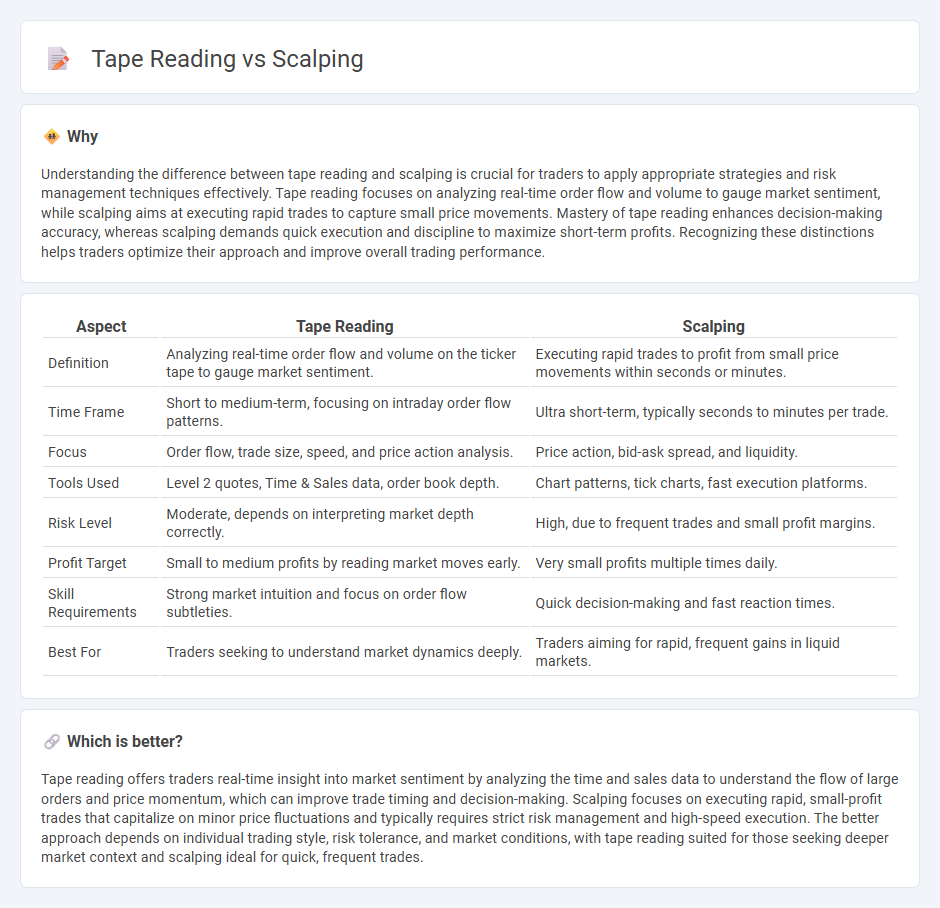
Tape reading involves analyzing real-time order flow and volume to anticipate market moves, providing traders with detailed insights into supply and demand dynamics. Scalping focuses on executing numerous quick trades to capture small price changes, often leveraging high-frequency strategies for rapid gains. Discover how mastering these techniques can enhance your trading precision and profitability.
Why it is important
Understanding the difference between tape reading and scalping is crucial for traders to apply appropriate strategies and risk management techniques effectively. Tape reading focuses on analyzing real-time order flow and volume to gauge market sentiment, while scalping aims at executing rapid trades to capture small price movements. Mastery of tape reading enhances decision-making accuracy, whereas scalping demands quick execution and discipline to maximize short-term profits. Recognizing these distinctions helps traders optimize their approach and improve overall trading performance.
Comparison Table
| Aspect | Tape Reading | Scalping |
|---|---|---|
| Definition | Analyzing real-time order flow and volume on the ticker tape to gauge market sentiment. | Executing rapid trades to profit from small price movements within seconds or minutes. |
| Time Frame | Short to medium-term, focusing on intraday order flow patterns. | Ultra short-term, typically seconds to minutes per trade. |
| Focus | Order flow, trade size, speed, and price action analysis. | Price action, bid-ask spread, and liquidity. |
| Tools Used | Level 2 quotes, Time & Sales data, order book depth. | Chart patterns, tick charts, fast execution platforms. |
| Risk Level | Moderate, depends on interpreting market depth correctly. | High, due to frequent trades and small profit margins. |
| Profit Target | Small to medium profits by reading market moves early. | Very small profits multiple times daily. |
| Skill Requirements | Strong market intuition and focus on order flow subtleties. | Quick decision-making and fast reaction times. |
| Best For | Traders seeking to understand market dynamics deeply. | Traders aiming for rapid, frequent gains in liquid markets. |
Which is better?
Tape reading offers traders real-time insight into market sentiment by analyzing the time and sales data to understand the flow of large orders and price momentum, which can improve trade timing and decision-making. Scalping focuses on executing rapid, small-profit trades that capitalize on minor price fluctuations and typically requires strict risk management and high-speed execution. The better approach depends on individual trading style, risk tolerance, and market conditions, with tape reading suited for those seeking deeper market context and scalping ideal for quick, frequent trades.
Connection
Tape reading involves analyzing real-time price and volume data to gauge market sentiment, which is crucial for scalpers aiming to execute rapid trades. By interpreting the order flow and identifying large transactions on the tape, scalpers can anticipate short-term price movements and optimize entry and exit points. This connection enhances trading precision, enabling scalpers to capitalize on minimal price fluctuations efficiently.
Key Terms
Timeframes
Scalping typically operates on ultra-short timeframes such as 1-minute or tick charts, enabling traders to capitalize on small price movements within seconds or minutes. Tape reading involves analyzing the time and sales data or the order flow to understand market sentiment and supply-demand dynamics in real-time, often on similarly short timeframes but emphasizing market depth and transaction speed. Explore more techniques and tools to master these fast-paced trading strategies.
Order Flow
Scalping and tape reading both revolve around analyzing order flow to capitalize on short-term price movements, with scalping emphasizing quick trades based on momentum and tape reading focusing on interpreting the real-time sequence of buy and sell orders. Order flow data provides crucial insights into market sentiment, liquidity, and potential reversals, empowering traders to make informed entry and exit decisions. Explore detailed strategies and tools to master order flow analysis and enhance trading precision.
Liquidity
Scalping capitalizes on high liquidity by executing rapid trades to profit from small price movements, while tape reading emphasizes analyzing real-time order flow and volume to understand market sentiment in liquid markets. Both strategies rely heavily on monitoring bid-ask spreads, trade sizes, and time and sales data to optimize entry and exit points. Explore deeper insights into liquidity's impact on these techniques to enhance your trading precision.
Source and External Links
Scalping (Day Trading Technique) - Corporate Finance Institute - Scalping is a day trading strategy where an investor buys and sells an individual stock multiple times within the same day aiming to make small profits on each trade, often targeting highly volatile stocks.
Scalping (trading) - Wikipedia - Scalping in trading can refer to a legitimate arbitrage method involving quick trades to capture small price gaps or a fraudulent market manipulation tactic; it usually involves very short holding periods and profiting from the bid-ask spread.
What is a scalping strategy in the stock market and how does it work? - Scalping uses rapid buying and selling supported by technical indicators like the Stochastic Oscillator, Moving Averages, and MACD to identify short-term price trends and reversals for quick profits.
 dowidth.com
dowidth.com